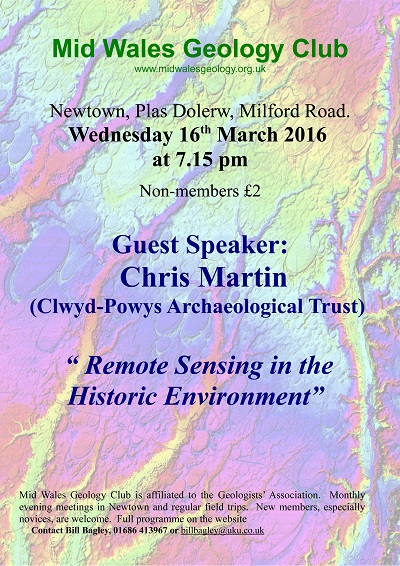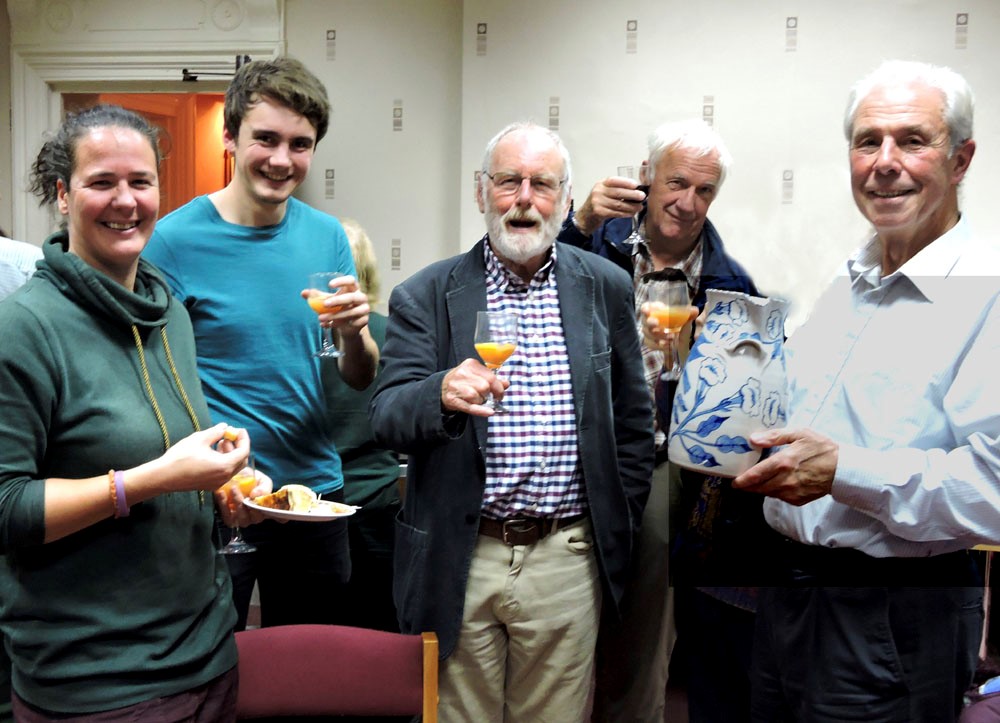Saturday 5th March 2016
Our next meeting will take place on Wednesday the 16th of March, where guest speaker Chris Martin of the Clwyd-Powys Archaeological Trust will present his talk "Remote Sensing in the Historic Environment"


On 20 January 2016 the AGM was followed as usual by a short talk, this year by Roy McGurn: ‘The Anthropocene: a new epoch in the making’. An excellent turnout of members showed that he had chosen his subject well. The suggestion is that the Earth is being pushed into a new geological phase in which humans have themselves become a force of nature, exerting a significant effect on our ecosystems. In 2009 the Subcommission on Quaternary Stratigraphy formed a working group with 38 members to examine the case for making the Anthropocene a new epoch. This International Anthropocene Working Group will report in 2016 to the International Commission on Stratigraphy, though a formal ratification can only be made by the International Union of Geological Sciences. Meanwhile the term Anthropocene is already being widely used but without agreement on when this new epoch might have begun. Estimates vary from around 12000 years ago the end of the last Ice Age, when human influence begins to show in the fossil record, up to 16 July 1945, the first testing of a nuclear weapon, and the characteristic isotope marker which resulted. The biggest changes began to be apparent with the start of the industrial revolution, say late 18th cent.
Roy explained the present structure of geological time scales, with twelve geological periods from the Cambrian, and more before that, each divided into epochs and further subdivided into ages. The first attempt to subdivide the geological system came from Giovanni Arduino in the 18th cent, a mere four divisions, further developed by Abraham Werner at the turn of the 18th to 19th cent. Sedgwick, Murchison and then Lapworth developed a more detailed sequence in the 19th cent, on the basis of rock lithology and fossils, but without any idea of actual timescales. Dating had to await the discovery of radioactive isotopes in the 20th cent. The most recent epoch, the Holocene (the last 10,700 years), was finally endorsed in 1969. Changes continue to be made: The Pridoli epoch was a subdivision inserted into the Silurian period even more recently. Each ratified boundary is exemplified with a GSSP (Global Stratotype Section and Point), which is a precise location colloquially referred to as a golden spike. Often the beginning of an epoch is defined as the first appearance of a new fossil species. The beginning of the Holocene is defined as a particular climate change.
If there is to be an Anthropocene, then the term itself means that some aspect of human interference with ecosystems should define the boundary. The Anthropocene seems to be a basically different concept. Does is succeed the Holocene? Or is it a further age of the Holocene? Or maybe even a replacement of the Holocene? Geology has to take the long view; perhaps we will know for sure the Anthropocene was a new epoch only after it has ended! The talk stimulated a lively discussion. Members drew attention to the many ways in which clear and permanent signals of our human activity are already appearing in the geological record: metallic lead from Roman times, exotic materials, new elements, nitrogen from fertilisers, junk in ocean sediments, even new species from experimental breeding and direct genetic manipulation.
The next meeting will be held on February 24th ( note this is the fourth Wednesday) when Prof. Jerry Davies will give a talk entitled: “Sea Level Changes in the Geological Past: recognising the record in the rocks.”
The next indoor meeting will be on Wednesday 20th January. This will be the AGM followed by a talk by Roy McGurn entitled “The Anthropocene: a new epoch in the making”.
At the final meeting of the year, members heard a highly entertaining talk by Prof. Alex Maltman on wine, whisky and beer and the role of geology.
To begin, we were introduced to the incredible claims made by those whose job it is to market wines. For example, “You can taste the tectonic plates”; “The wine's secret is the grey-blue Devonian slate”; “Our Shiraz grows on soils 500 million years old”. The use of terms like earthy and stony also reflect the geological role. Yet the role of geology is more related to factors of slope, aspect, inclination, air flow patterns and drainage.
Similarly with whisky. Here the role of water (particularly if they are crystal waters tumbling from granite) is lauded by the advertising companies. Yet again their claims bare little resemblance to reality.
With beer it is slightly different. The very different mineral content of the water in places like Burton, Dublin and Pilsen, determines their very different types of beer. Or it did! Today the water composition is adjusted by the brewing specialists and you can make most types of beer anywhere. The meeting ended with a lively discussion followed by a finger buffet and mulled fruit juice. Professor Maltman was presented with a nice bottle of chianti. You can taste the soils of Tuscany in this wine!
